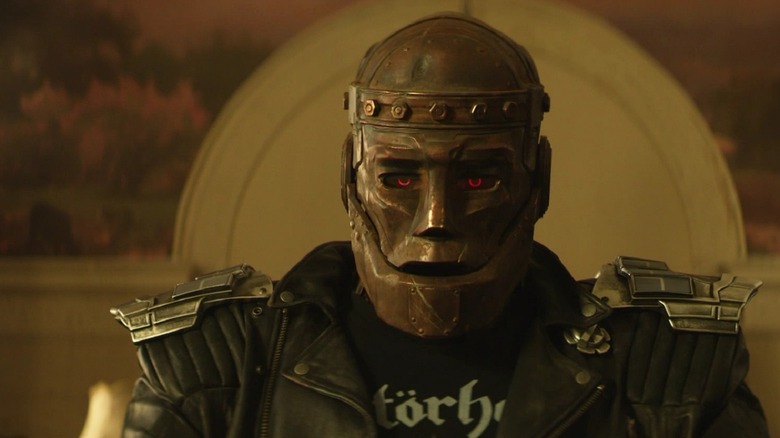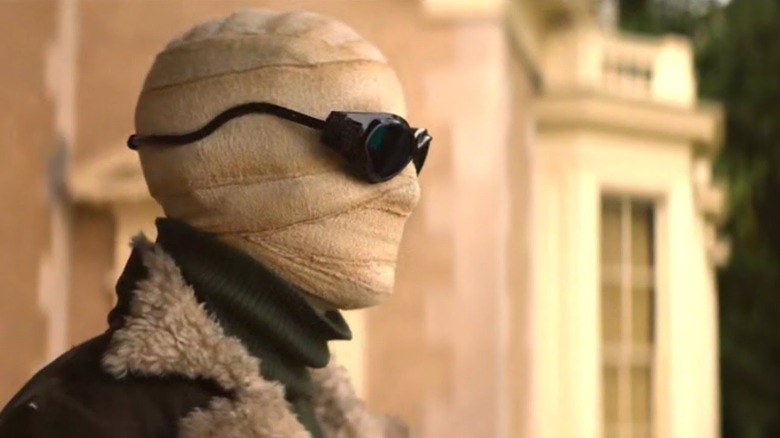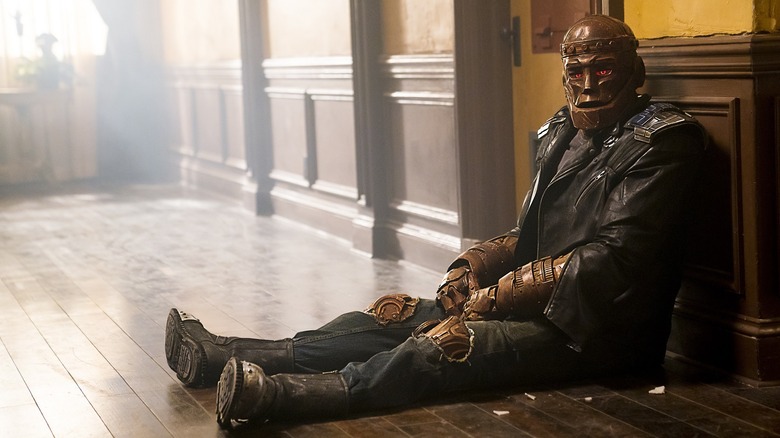How Doom Patrol Makes Faceless Characters Feel Alive
"Doom Patrol" is an unconventional superhero show (if you can call it that) on so many levels. With a lot less punching than what's expected from a typical DC or Marvel comics adaptation, "Doom Patrol" is more about introspection than it is about defeating the next bad guy or saving the world. Sure, that introspection is done via werewolf butts and living streets, but that only helps to move the characters forward and bring incredibly emotional moments to the show.
The most surprising aspect of "Doom Patrol" is its ability to convey such powerful character moments and emotions with characters who don't have the most expressive faces, which is putting it lightly.
Robotman and Negative Man, two of the main characters of "Doom Patrol," are both characters that have their faces covered. Robotman is a robot suit, and Negative Man is a character covered in bandages. Moreover, both characters are voiced by different actors than the ones that portray them physically on set. Brendan Fraser voices Robotman while the character is brought to life on set by Riley Shanahan. Negative Man is voiced by Matt Bomer and portrayed on set by Matthew Zuk. The faces of these two characters are never expressive but somehow are still at the center of some of the most emotional moments of the series.
Risking a lack of empathy
"Doom Patrol" show-runner Jeremy Carver spoke to Entertainment Weekly about Robotman and Negative Man's emotional journeys and the uncertainty of being able to pull that off for characters whose faces you can't see:
"It didn't really hit me until a couple of weeks before shooting that we had five-page scenes between Robotman and Negative Man in which neither one has a moving mouth, you can't see their faces, and the people talking aren't actually the people in the scene. It felt exciting but also a little scary!"
The show's ability to take risks is part of the reason "Doom Patrol" has been so critically successful. Its approach to characters, no matter their appearance or lack of real faces, helps to give a level of authenticity to "Doom Patrol." Even characters like Robotman, who is only a human brain in a robot body, have feelings and emotions too. Each character in "Doom Patrol" had a traumatic experience, forcing themselves to accept the person they have become. Negative Man and Robotman had both lost what they considered their "normal bodies," going through a phase of resentment and acceptance.
For Robotman and Negative Man to appear emotionally vulnerable, the four actors involved needed to develop a collaboration to make the scenes the best they could be. Carver described the process, which involved the actors studying each other and their movements very carefully.
Four actors for two characters
According to Carver, the two Robotman actors went through a thorough process working with each other:
"We took the two Robotman actors, Brendan and Riley, in a room, and they frankly studied one another. Riley studied Brendan's movements and his acting/speech patterns."
"Doom Patrol" is beloved for refusing to play it safe. But in the case of this particular scene, there was an extra level of risk with Carver not sure of how the performance would turn out (via EW):
"We took something of a risk because we had Brendan perform a scratch track before each episode, but Riley performed the scene on the set. He's listening to Brendan's voice and reacting to that, Riley performs it, but Even before I see the cut, they lay in the scratch track from Brendan, which we then refine with additional performance. My point is, it's not until weeks and weeks after we shot the first episode that we got a sense of whether it actually worked, and by then, we were well on to shooting other episodes."
Carver and those involved with "Doom Patrol's" production would have to put their faith in the work of their actors. The hit HBO Max series didn't get this far by not taking risks with its characters and story. Robotman's need for human connection and how Fraser and Shanahan translate that to the screen would pay off tremendously while teaching Carver about making a compelling character.
Being different makes us the same
Carver and co.'s method of bringing emotion to the two characters worked out, as he was more than pleased with the results:
"It was a moment of relief, and frankly a moment of magic, to see how Brendan, Riley, Matt, and Matthew worked so well in concert with one another. It was one of those things that, had it not worked, it could've been a disaster! The fact that it did work was miraculous."
In a separate interview for Collider, Carver shared the lesson he learned after working with characters like Robotman who don't have a face to express themselves:
"We realized that not everyone's mouth has to move for them to be an affecting character. You can have a lot of different characters that aren't necessarily what people might be expecting to see."
"Doom Patrol" is a show about self-acceptance and celebrating being different. So it only makes sense that two of the most out-there characters express themselves differently than what is expected in a series. Robotman's physicality and f-bomb-filled dialogue, courtesy of Fraser, bring the character to life unexpectedly while giving audiences a character they can empathize with. Negative Man's acceptance of himself and his sexuality, paired with his powers, also makes for a timely message while making two faceless characters feel more alive. These two characters show us that while our struggles may be wildly different, the process of going through the struggle makes us the same.



